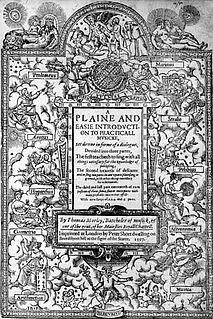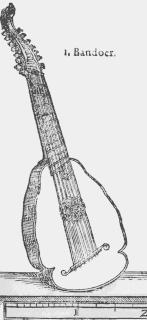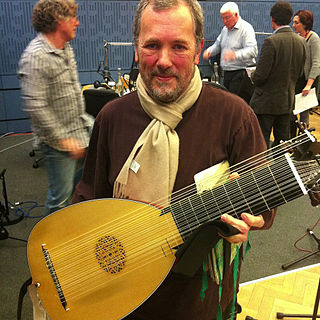
The viol, viola da gamba, or informally gamba, is any one of a family of bowed, fretted and stringed instruments with hollow wooden bodies and pegboxes where the tension on the strings can be increased or decreased to adjust the pitch of each of the strings. Frets on the viol are usually made of gut, tied on the fingerboard around the instrument's neck, to enable the performer to stop the strings more cleanly. Frets improve consistency of intonation and lend the stopped notes a tone that better matches the open strings. Viols first appeared in Spain in the mid to late 15th century and were most popular in the Renaissance and Baroque (1600–1750) periods. Early ancestors include the Arabic rebab and the medieval European vielle, but later, more direct possible ancestors include the Venetian viole and the 15th- and 16th-century Spanish vihuela, a 6-course plucked instrument tuned like a lute that looked like but was quite distinct from the 4-course guitar.
Thomas Robinson was an English Renaissance composer and music teacher, who flourished around 1600. He taught and wrote music for lute, cittern, orpharion, bandora, viol, and voice.

Thomas Morley was an English composer, theorist, singer and organist of the Renaissance. He was one of the foremost members of the English Madrigal School. Referring to the strong Italian influence on the English madrigal, The New Grove Dictionary of Music and Musicians states that Morley was "chiefly responsible for grafting the Italian shoot on to the native stock and initiating the curiously brief but brilliant flowering of the madrigal that constitutes one of the most colourful episodes in the history of English music."
The Baltimore Consort is a musical ensemble that performs a wide variety of early music, Renaissance music and music from later periods. They began in 1980 as a group specializing in music of the Elizabethan period, but soon expanded their repertoire to include Scottish music, broadside ballads, and Italian, French, and other European music of the 16th and 17th centuries. Their music bridges the genres of classical and folk music.

The bandora or bandore is a large long-necked plucked string-instrument that can be regarded as a bass cittern though it does not have the re-entrant tuning typical of the cittern. Probably first built by John Rose in England around 1560, it remained popular for over a century. A somewhat smaller version was the orpharion.

Anthony [Antony] Holborne [Holburne] was a composer of music for lute, cittern, and instrumental consort during the reign of Queen Elizabeth I.

A consort of instruments was a phrase used in England during the 16th and 17th centuries to indicate an instrumental ensemble. These could be of the same or a variety of instruments. Consort music enjoyed considerable popularity at court and in households of the wealthy in the Elizabethan era and many pieces were written for consorts by the major composers of the period. In the Baroque era consort music was absorbed into chamber music.

During the reign of Queen Elizabeth I (1558–1603), English art and high culture reached a pinnacle known as the height of the English Renaissance. Elizabethan music experienced a shift in popularity from sacred to secular music and the rise of instrumental music. Professional musicians were employed by the Church of England, the nobility, and the rising middle-class.

The orpharion or opherion is a plucked stringed instrument from the Renaissance, a member of the cittern family. Its construction is similar to the larger bandora and an ancestor of the guitar. The metal strings are tuned like a lute and are plucked with the fingers. The nut and bridge of an orpharion are typically sloped, so that the string length increases from treble to bass. Due to the extremely low-tension metal strings, which would easily distort the notes when pushed down, the frets were almost flush with the fingerboard, which was gently scalloped. As with all metal-strung instruments of the era, a very light touch with the plucking hand was required, quite different from the sharper attack used on the lute.

Philip Rosseter was an English composer and musician, as well as a theatrical manager. His family seems to have been from Somerset or Lincolnshire, he may have been employed with the Countess of Sussex by 1596, and he was living in London by 1598. In 1604 Rosseter was appointed a court lutenist for James I of England, a position he held until his death in 1623. Rosseter is best known for A Book of Ayres which was written with Thomas Campion and published in 1601. Some literary critics have held that Campion wrote the poems for Rosseter's songs; however, this seems not to be the case. It is likely that Campion was the author of the book's preface, which criticizes complex counterpoint and "intricate" harmonies that leave the words inaudible. The two men had a close professional and personal relationship; when Campion died in 1620, he had named Rosseter his sole heir.
Richard Al(l)ison was an English composer. He wrote de la Tromba, a fine broken consort piece which has several professional recordings and first became well known due to the Julian Bream Consort.
The Ceterone (Italian), was an enlarged cetera, believed to be similar to the chitarrone as a development of the chitarra and lute to enhance the bass capabilities of these instruments.
"Flow, my tears" is a lute song by the accomplished lutenist and composer John Dowland (1563–1626). Originally composed as an instrumental under the name "Lachrimae pavane" in 1596, it is Dowland's most famous ayre, and became his signature song, literally as well as metaphorically: he would occasionally sign his name "Jo: dolandi de Lachrimae".
Lynda Sayce is a British lutenist and theorbo player, known also as a scholar of musical history and a writer on the history of the lute and theorbo.
Martin Peerson was an English composer, organist and virginalist. Despite Roman Catholic leanings at a time when it was illegal not to subscribe to Church of England beliefs and practices, he was highly esteemed for his musical abilities and held posts at St Paul's Cathedral and, it is believed, Westminster Abbey. His output included both sacred and secular music in forms such as consort music, keyboard pieces, madrigals and motets.

Nigel North is an English lutenist, musicologist, and pedagogue.

William Barley (1565?–1614) was an English bookseller and publisher. He completed an apprenticeship as a draper in 1587, but was soon working in the London book trade. As a freeman of the Drapers' Company, he was embroiled in a dispute between it and the Stationers' Company over the rights of drapers to function as publishers and booksellers. He found himself in legal tangles throughout his life.
Sydney Beck was an American musicologist, music educator, violinist and viol player. As a scholar, he was considered an authority on English music of the 16th through 18th centuries. One of his major contributions was his research on composer Thomas Morley which led to the modern publication of Morley's The First Book of Consort Lessons in 1959. Beck led his own ensemble, The Consort Players, in performances of Morley's music and other works by Morley's contemporaries; performances which contributed to the interest in reviving broken consort music in the 20th century.

Edward Paston (1550–1630), second son of Sir Thomas Paston, was a Catholic gentleman of Norfolk, a poet, and amateur musician living in the reign of Elizabeth I. He is an important figure in the musical history of England, his love of music driving him to acquire and copy musical manuscripts from some of the most important composers of the Renaissance, resulting in a unique performing collection of 16th-century house music that included works by William Byrd, Thomas Tallis, John Taverner, and Orlando di Lasso. He was especially interested in Byrd, and one of his books is the largest source of consort songs by that composer. Paston played the lute, creating a wide range of vocal settings and accompanying tablatures in partbooks that are still obtainable. As a young man he travelled extensively in Spain, being influenced by the Spanish form of tablature, as seen in his partbooks, rather than the generally used French form.
Ian Harwood was a lutenist, musical instrument maker and teacher.











